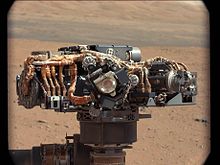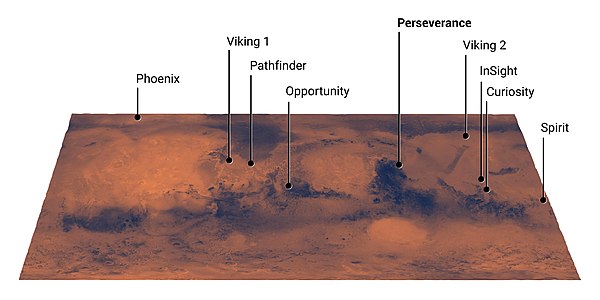Mars rover: Difference between revisions
m Fix grammar |
Change number of successful robotically operated Mars rovers to 5, as there are 5 listed. |
||
| Line 5: | Line 5: | ||
A '''Mars rover''' is a [[motor vehicle]] that travels across the surface of the planet [[Mars]] upon arrival. [[Rover (space exploration)|Rovers]] have several advantages over stationary [[Lander (spacecraft)|landers]]: they examine more territory, they can be directed to interesting features, they can place themselves in sunny positions to weather winter months, and they can advance the knowledge of how to perform very remote [[robot]]ic vehicle control. |
A '''Mars rover''' is a [[motor vehicle]] that travels across the surface of the planet [[Mars]] upon arrival. [[Rover (space exploration)|Rovers]] have several advantages over stationary [[Lander (spacecraft)|landers]]: they examine more territory, they can be directed to interesting features, they can place themselves in sunny positions to weather winter months, and they can advance the knowledge of how to perform very remote [[robot]]ic vehicle control. |
||
There have been |
There have been five successful robotically operated Mars rovers, all managed by the [[Jet Propulsion Laboratory]]: ''[[Sojourner (rover)|Sojourner]]'', ''[[Opportunity (rover)|Opportunity]]'', ''[[Spirit (rover)|Spirit]]'', ''[[Curiosity (rover)|Curiosity]]'', and ''[[Perseverance (rover)|Perseverance]]''. On January 24, 2016, [[NASA]] reported that [[Timeline of Mars Science Laboratory#Current status|current studies]] on Mars by ''Curiosity'' and ''Opportunity'' (the latter now defunct) would be searching for evidence of ancient life, including a [[biosphere]] based on [[autotroph]]ic, [[chemotroph]]ic or [[Lithotroph#Chemolithotrophs|chemolithoautotrophic]] [[microorganism]]s, as well as ancient water, including [[Lacustrine plain|fluvio-lacustrine environments]] ([[plain]]s related to ancient [[river]]s or [[lake]]s) that may have been [[Planetary habitability|habitable]].<ref name="SCI-20140124a">{{cite journal |last=Grotzinger |first=John P. |title=Introduction to Special Issue - Habitability, Taphonomy, and the Search for Organic Carbon on Mars |journal=[[Science (journal)|Science]] |date=January 24, 2014 |volume=343 |number=6169 |pages=386–387 |doi=10.1126/science.1249944 |pmid=24458635|bibcode = 2014Sci...343..386G |doi-access=free }}</ref><ref name="SCI-20140124special">{{cite journal |authors=Various |title=Special Issue - Table of Contents - Exploring Martian Habitability |url=http://www.sciencemag.org/content/343/6169.toc#SpecialIssue |date=January 24, 2014|journal=[[Science (journal)|Science]] |volume=343 |number=6169 |pages=345–452 |access-date=24 January 2014 }}</ref><ref name="SCI-20140124">{{cite journal |authors=Various |title=Special Collection - Curiosity - Exploring Martian Habitability |url=http://www.sciencemag.org/site/extra/curiosity/|date=January 24, 2014 |journal=[[Science (journal)|Science]] |access-date=January 24, 2014 }}</ref><ref name="SCI-20140124c">{{cite journal |authors=Grotzinger, J.P. |title=A Habitable Fluvio-Lacustrine Environment at Yellowknife Bay, Gale Crater, Mars |date=January 24, 2014 |journal=[[Science (journal)|Science]] |volume=343 |number=6169 |doi=10.1126/science.1242777 |display-authors=etal |pmid=24324272 |pages=1242777|bibcode = 2014Sci...343A.386G |citeseerx=10.1.1.455.3973 |s2cid=52836398 }}</ref><ref>{{Cite web|date=2020-12-30|title=Planetary Scientists Have Created a Map of Mars' Entire Ancient River Systems|url=https://www.universetoday.com/149441/planetary-scientists-have-created-a-map-of-mars-entire-ancient-river-systems/|access-date=2020-12-31|website=Universe Today|language=en-US}}</ref> The search for evidence of [[Planetary habitability|habitability]], [[taphonomy]] (related to [[fossils]]), and [[organic carbon]] on Mars is now a primary NASA objective.<ref name="SCI-20140124a" /> In June 2018, ''Opportunity'' went out of contact after going into hibernation mode in a dust storm.<ref>[https://mars.nasa.gov/mer/mission/rover-status/opportunity/recent/all/?y=2018 Mars Exploration Rover - Opportunity mission updates], mars.nasa.gov</ref> NASA declared the end of the ''Opportunity'' mission on February 13, 2019, after numerous failures to wake up the rover.<ref>{{cite web|url=https://www.telegraph.co.uk/science/2019/02/13/nasa-declares-mars-rover-opportunity-dead-15-years-red-planet/|title=NASA declares Mars rover Opportunity dead after 15 years on the red planet|date=February 13, 2019|work=[[The Daily Telegraph]]}}</ref> On February 18, 2021, Perseverance landed on the red planet. |
||
[[Mars 2]] and [[Mars 3]] were physically tethered probes; ''Sojourner'' was dependent on the Mars Pathfinder base station for communication with Earth; MER-A & B and ''Curiosity'' were on their own. As of {{CURRENTMONTHNAME}} {{CURRENTYEAR}}, ''Curiosity'' is still active, while ''Spirit'', ''Opportunity'', and ''Sojourner'' completed their missions before losing contact. |
[[Mars 2]] and [[Mars 3]] were physically tethered probes; ''Sojourner'' was dependent on the Mars Pathfinder base station for communication with Earth; MER-A & B and ''Curiosity'' were on their own. As of {{CURRENTMONTHNAME}} {{CURRENTYEAR}}, ''Curiosity'' is still active, while ''Spirit'', ''Opportunity'', and ''Sojourner'' completed their missions before losing contact. |
||
Revision as of 21:11, 18 February 2021

A Mars rover is a motor vehicle that travels across the surface of the planet Mars upon arrival. Rovers have several advantages over stationary landers: they examine more territory, they can be directed to interesting features, they can place themselves in sunny positions to weather winter months, and they can advance the knowledge of how to perform very remote robotic vehicle control.
There have been five successful robotically operated Mars rovers, all managed by the Jet Propulsion Laboratory: Sojourner, Opportunity, Spirit, Curiosity, and Perseverance. On January 24, 2016, NASA reported that current studies on Mars by Curiosity and Opportunity (the latter now defunct) would be searching for evidence of ancient life, including a biosphere based on autotrophic, chemotrophic or chemolithoautotrophic microorganisms, as well as ancient water, including fluvio-lacustrine environments (plains related to ancient rivers or lakes) that may have been habitable.[2][3][4][5][6] The search for evidence of habitability, taphonomy (related to fossils), and organic carbon on Mars is now a primary NASA objective.[2] In June 2018, Opportunity went out of contact after going into hibernation mode in a dust storm.[7] NASA declared the end of the Opportunity mission on February 13, 2019, after numerous failures to wake up the rover.[8] On February 18, 2021, Perseverance landed on the red planet.
Mars 2 and Mars 3 were physically tethered probes; Sojourner was dependent on the Mars Pathfinder base station for communication with Earth; MER-A & B and Curiosity were on their own. As of August 2024, Curiosity is still active, while Spirit, Opportunity, and Sojourner completed their missions before losing contact.
US Missions

Seven rovers have been dispatched to Mars:
 Mars 2, Prop-M rover, 1971, Mars 2 landing failed taking Prop-M with it. The Mars 2 and 3 spacecraft from the Soviet Union had identical 4.5 kg Prop-M rovers. They were to move on skis while connected to the landers with cables.[9]
Mars 2, Prop-M rover, 1971, Mars 2 landing failed taking Prop-M with it. The Mars 2 and 3 spacecraft from the Soviet Union had identical 4.5 kg Prop-M rovers. They were to move on skis while connected to the landers with cables.[9] Mars 3, Prop-M rover, 1971, lost when Mars 3 lander stopped communicating about 104.5 seconds after landing.[9]
Mars 3, Prop-M rover, 1971, lost when Mars 3 lander stopped communicating about 104.5 seconds after landing.[9] Sojourner rover, Mars Pathfinder, landed successfully on July 4, 1997. Communications were lost on September 27, 1997.
Sojourner rover, Mars Pathfinder, landed successfully on July 4, 1997. Communications were lost on September 27, 1997. Spirit (MER-A), Mars Exploration Rover (MER), launched on June 10, 2003,[10] and landed on January 4, 2004. Nearly 6 years after the original mission limit, Spirit had covered a total distance of 7.73 km (4.80 mi) but its wheels became trapped in sand.[11] The last communication received from the rover was on March 22, 2010, and NASA ceased attempts to re-establish communication on May 25, 2011.[12]
Spirit (MER-A), Mars Exploration Rover (MER), launched on June 10, 2003,[10] and landed on January 4, 2004. Nearly 6 years after the original mission limit, Spirit had covered a total distance of 7.73 km (4.80 mi) but its wheels became trapped in sand.[11] The last communication received from the rover was on March 22, 2010, and NASA ceased attempts to re-establish communication on May 25, 2011.[12] Opportunity (MER-B), Mars Exploration Rover, launched on July 7, 2003[10] and landed on January 25, 2004. Opportunity surpassed the previous records for longevity at 5,352 sols (5498 Earth days from landing to mission end; 15 Earth years or 8 Martian years) and coverance of 45.16 km (28.06 mi). The rover sent its last status on 10 June 2018 when a global 2018 Mars dust storm blocked the sunlight needed to recharge its batteries.[13] After hundreds of attempts to reactivate the rover, NASA declared the mission complete on February 13, 2019.
Opportunity (MER-B), Mars Exploration Rover, launched on July 7, 2003[10] and landed on January 25, 2004. Opportunity surpassed the previous records for longevity at 5,352 sols (5498 Earth days from landing to mission end; 15 Earth years or 8 Martian years) and coverance of 45.16 km (28.06 mi). The rover sent its last status on 10 June 2018 when a global 2018 Mars dust storm blocked the sunlight needed to recharge its batteries.[13] After hundreds of attempts to reactivate the rover, NASA declared the mission complete on February 13, 2019. Curiosity of the Mars Science Laboratory (MSL) mission by NASA, was launched November 26, 2011[14][15] and landed at the Aeolis Palus plain near Aeolis Mons (informally "Mount Sharp")[16][17][18][19] in Gale Crater on August 6, 2012.[20][21][22] The Curiosity rover is still operational as of August 2021.
Curiosity of the Mars Science Laboratory (MSL) mission by NASA, was launched November 26, 2011[14][15] and landed at the Aeolis Palus plain near Aeolis Mons (informally "Mount Sharp")[16][17][18][19] in Gale Crater on August 6, 2012.[20][21][22] The Curiosity rover is still operational as of August 2021. Perseverance, The 2.7 billion NASA rover based on the successful Curiosity design, launched on July 30, 2020 with the Mars Helicopter Ingenuity attached to its belly, landed on February 18, 2021[23]
Perseverance, The 2.7 billion NASA rover based on the successful Curiosity design, launched on July 30, 2020 with the Mars Helicopter Ingenuity attached to its belly, landed on February 18, 2021[23]

En-route
Tianwen-1, a Chinese project, launched on July 23, 2020 and successfully reached Mars orbit on February 10, 2021.[24]
Planned
The European-Russian ExoMars rover Rosalind Franklin is planned to launch in 2022.
Proposed
The JAXA Melos rover is to be launched in 2022.
Undeveloped

- Astrobiology Field Laboratory, proposed in the 2000-2010 period as a follow on to MSL.[25]
- Mars Astrobiology Explorer-Cacher (MAX-C), cancelled 2011[26][27]
- Mars Surveyor 2001 rover,[28]
- Zephyr rover, would use a rigid sail for wind propulsion.
- Mars Tumbleweed Rover, a spherical wind-propelled rover.[29][30]
- In 2018, a kind of cushion-air rover was proposed,[31] which in contrast with traditional hovercraft does not use blowers to pressurize the gas in the chamber but rather uses stored pressurized CO2 obtained from a freezing process which does not require mechanical compression.[32]

Examples of instruments

(February 14−20, 2018 / sols 4998−5004) It was taken with its microscopic imager instrument
Examples of instruments onboard landed rovers include:
- Alpha particle X-ray spectrometer (MPF + MER + MSL)
- CheMin (MSL)
- Chemistry and Camera complex (MSL)
- Dynamic Albedo of Neutrons (MSL)
- Hazcam (MER + MSL)
- MarsDial (MER + MSL)
- Materials Adherence Experiment (MPF)
- MIMOS II (MER)
- Mini-TES (MER)
- Mars Hand Lens Imager (MSL)
- Navcam (MER + MSL)
- Pancam (MER)
- Rock Abrasion Tool (MER)
- Radiation assessment detector (MSL)
- Rover Environmental Monitoring Station (MSL)
- Sample Analysis at Mars (MSL)
Mars landing locations


NASA Mars rover goals (circa 2010s)
NASA distinguishes between "mission" objectives and "science" objectives. Mission objectives are related to progress in space technology and development processes. Science objectives are met by the instruments during their mission in space.
The science instruments are chosen and designed based on the science objectives and goals. The primary goal of the Spirit and Opportunity rovers was to investigate "the history of water on Mars".[33]
The four science goals of NASA's long-term Mars Exploration Program are:
- Determine whether life ever arose on Mars
- Characterize the climate of Mars
- Characterize the geology of Mars
- Prepare for human exploration of Mars[34]
Gallery
- Mars Rovers
-
Soviet Mars rover Prop-M (1972)
-
Sojourner rover on Mars
-
Sojourner rover atop Pathfinder lander
-
Comparison of wheels: Mars Sojourner rover, MER, MSL
-
Comparison: MER, Sojourner rover, MSL
-
Comparison: MER, Sojourner rover, humans, MSL
-
Concept: Crewed Mars rover
-
Martian sunset viewed by the Spirit rover (May 2005)
See also
- Astrobiology
- Comparison of embedded computer systems on board the Mars rovers
- Crewed Mars rover
- InSight lander
- List of artificial objects on Mars
- List of rovers on extraterrestrial bodies
- Mars Exploration Rover
- Mars-Grunt
- Mars Pathfinder
- Mars Reconnaissance Orbiter
- 2001 Mars Odyssey
- Radiation hardening
- Scientific information from the Mars Exploration Rover mission
References
- ^ Mark Rober [@MarkRober] (May 3, 2020). "CONFESSION: when I was at @NASA I created this image from our CAD model of the rover before it launched" (Tweet) – via Twitter.
- ^ a b Grotzinger, John P. (January 24, 2014). "Introduction to Special Issue - Habitability, Taphonomy, and the Search for Organic Carbon on Mars". Science. 343 (6169): 386–387. Bibcode:2014Sci...343..386G. doi:10.1126/science.1249944. PMID 24458635.
- ^ "Special Issue - Table of Contents - Exploring Martian Habitability". Science. 343 (6169): 345–452. January 24, 2014. Retrieved 24 January 2014.
{{cite journal}}: Cite uses deprecated parameter|authors=(help) - ^ "Special Collection - Curiosity - Exploring Martian Habitability". Science. January 24, 2014. Retrieved January 24, 2014.
{{cite journal}}: Cite uses deprecated parameter|authors=(help) - ^ "A Habitable Fluvio-Lacustrine Environment at Yellowknife Bay, Gale Crater, Mars". Science. 343 (6169): 1242777. January 24, 2014. Bibcode:2014Sci...343A.386G. CiteSeerX 10.1.1.455.3973. doi:10.1126/science.1242777. PMID 24324272. S2CID 52836398.
{{cite journal}}: Cite uses deprecated parameter|authors=(help) - ^ "Planetary Scientists Have Created a Map of Mars' Entire Ancient River Systems". Universe Today. 2020-12-30. Retrieved 2020-12-31.
- ^ Mars Exploration Rover - Opportunity mission updates, mars.nasa.gov
- ^ "NASA declares Mars rover Opportunity dead after 15 years on the red planet". The Daily Telegraph. February 13, 2019.
- ^ a b "Mars 2 Lander". NASA NSSDC. Retrieved 2008-06-25.
- ^ a b "Mars Exploration". 10 August 2012. Retrieved 2012-08-10.
- ^ Boyle, Alan. "Good moves on Mars". MSNBC. Archived from the original on 2010-01-23. Retrieved 2010-01-22.
- ^ "NASA Concludes Attempts To Contact Mars Rover Spirit". NASA. May 24, 2011.
- ^ "Mars Exploration Rover Mission: All Opportunity Updates". mars.nasa.gov. Retrieved 31 October 2018.
- ^ "Mars Science Laboratory Launch". 26 November 2011. Retrieved 2011-11-26.
- ^ "NASA Launches Super-Size Rover to Mars: 'Go, Go!'". New York Times. Associated Press. 26 November 2011. Retrieved 2011-11-26.
- ^ USGS (16 May 2012). "Three New Names Approved for Features on Mars". USGS. Archived from the original on 28 July 2012. Retrieved 28 May 2012.
- ^ NASA Staff (27 March 2012). "'Mount Sharp' on Mars Compared to Three Big Mountains on Earth". NASA. Retrieved 31 March 2012.
- ^ Agle, D. C. (28 March 2012). "'Mount Sharp' On Mars Links Geology's Past and Future". NASA. Retrieved 31 March 2012.
- ^ Staff (29 March 2012). "NASA's New Mars Rover Will Explore Towering 'Mount Sharp'". Space.com. Retrieved 30 March 2012.
- ^ Webster, Guy; Brown, Dwayne (22 July 2011). "NASA's Next Mars Rover To Land At Gale Crater". NASA JPL. Retrieved 2011-07-22.
- ^ Chow, Dennis (22 July 2011). "NASA's Next Mars Rover to Land at Huge Gale Crater". Space.com. Retrieved 2011-07-22.
- ^ Amos, Jonathan (22 July 2011). "Mars rover aims for deep crater". BBC News. Retrieved 2011-07-22.
- ^ "Nasa's Perseverance rover lands on Mars". BBC News. 18 February 2021. Retrieved 2021-02-18.
- ^ Gebhardt, Chris (February 10, 2021). "China, with Tianwen-1, begins tenure at Mars with successful orbital arrival".
- ^ [1]
- ^ de Selding, Peter B. (20 April 2011). "ESA Halts Work on ExoMars Orbiter and Rover". Space News. Retrieved 2011-04-21.
- ^ Svitak, Amy (18 April 2011). "U.S., Europe Plan Single-rover Mars Mission for 2018". Space News. Retrieved 2011-04-21.
- ^ "NASA - NSSDCA - Spacecraft - Details".
- ^ Kimberly W. Land (May 13, 2003). "A new way to explore the surface of Mars". NASA. Retrieved 2011-04-04.
- ^ The Tumbleweed Rover is on a Roll. Anna Heiney, KSC NASA. 11 March 2004.
- ^ Arias, Francisco. J (2018). "CO2-Cushion Vehicle for Mars. An Alternative Locomotion for Exploration Rovers". 2018 Joint Propulsion Conference. doi:10.2514/6.2018-4492. ISBN 978-1-62410-570-8.
{{cite book}}:|journal=ignored (help) - ^ Arias, Francisco. J (2018). "A Method of Attaining High Pressurized Vessels in Space, the Moon and With Particular Reference to Mars". 2018 International Energy Conversion Engineering Conference. doi:10.2514/6.2018-4488. ISBN 978-1-62410-571-5.
{{cite book}}:|journal=ignored (help) - ^ "Mars Exploration Rover Mission: Overview". marsrovers.nasa.gov. Archived from the original on 2012-08-28. Retrieved 2008-06-25.
- ^ "Mars Exploration Rover Mission: Science – Looking for signs of past water on Mars". marsrovers.nasa.gov. Archived from the original on 2008-05-22. Retrieved 2008-06-25.













